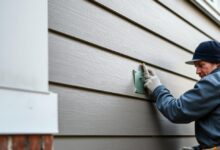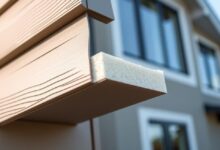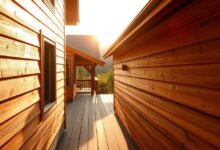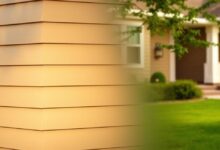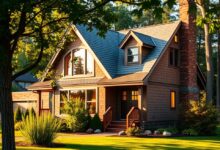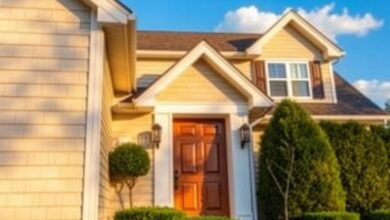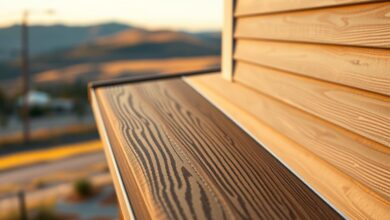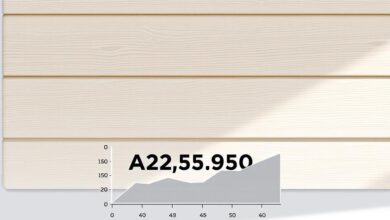Insulated Siding: Enhance Home Insulation
Homeowners are always looking for ways to make their homes more energy efficient and comfortable. One great way is to get insulated siding. It not only makes your home look better but also helps it stay warmer or cooler inside.
With insulated siding, your home will have a steady temperature. You’ll also save money on your energy bills and enjoy a quieter home. This siding is made to keep heat in and cold out, making it a smart choice for better home insulation.
Key Takeaways
- Insulated siding improves home energy efficiency.
- It provides a significant boost to home insulation.
- Homeowners can enjoy reduced energy bills.
- A more consistent indoor temperature is maintained.
- It minimizes heat transfer and reduces air leakage.
Understanding Insulated Siding
Insulated siding is a new way to cover your home’s exterior. It makes your home more energy-efficient. It combines the protection of regular siding with insulation.
What Is Insulated Siding?
Insulated siding is siding that has insulation built right in. It’s made from materials like vinyl, fiber cement, or engineered wood. These materials give your home a higher R-value than regular siding.
How Insulated Siding Works
Insulated siding works by stopping heat from moving between the outside and inside of your home. It cuts down on thermal bridging. This means your home stays at a steady temperature, so you don’t need to use as much heat or air conditioning.
Core Components and Structure
Insulated siding has a few key parts. There’s the siding material, a foam insulation layer, and sometimes a backing material. How these parts work together affects the siding’s R-value and how long it lasts.
| Component | Function | Benefit |
|---|---|---|
| Siding Material | Provides exterior protection | Durability and aesthetic appeal |
| Foam Insulation Layer | Reduces heat transfer | Improved energy efficiency |
| Backing Material | Adds structural integrity | Enhanced stability |
Insulated Siding for Better Insulation: How It Outperforms Traditional Options
Insulated siding is a big step up in home insulation, beating out old siding materials. It stands out because it offers more thermal resistance than traditional siding.
R-Value Comparison
The R-value shows how well a material stops heat flow. Insulated siding usually has a higher R-value than old siding. For example, vinyl siding might have an R-value of 0.6. But, insulated siding can range from 3 to 5 or more, depending on the brand.
| Siding Type | R-Value |
|---|---|
| Traditional Vinyl Siding | 0.6 |
| Insulated Siding | 3-5+ |
Thermal Bridging Prevention
Thermal bridging happens when there’s a gap in insulation. Insulated siding stops this by covering the whole building. This cuts down on heat loss and saves energy.
Continuous Insulation Benefits
Insulated siding keeps your home energy-efficient with continuous insulation. It fills gaps and keeps insulation even. This lowers energy costs and makes your home more comfortable.
Choosing insulated siding means better energy use, less thermal bridging, and a steady indoor climate. It’s a top pick for anyone wanting to improve their home’s insulation.
Types of Insulated Siding Materials
The market has many insulated siding options, like vinyl, fiber cement, and wood-look. These choices fit different budgets, tastes, and needs. This makes it easier for homeowners to pick the right siding for their homes.
Vinyl Insulated Siding
Vinyl insulated siding is loved for its durability and low maintenance. It can handle many weather conditions and comes in many colors and styles. It’s also energy efficient, keeping your home cooler.
Fiber Cement Insulated Options
Fiber cement insulated siding is durable and fire-resistant. It’s made from cement, sand, and cellulose fibers. You can paint it to fit your home’s style and it resists pests and weather.
Wood-Look Insulated Products
Wood-look insulated siding is great for those who love the look of wood. It looks like real wood but is more durable and resistant to rot and insects. You can find it in many styles, from classic to modern.
Foam Backing Variations
Foam backing is key for insulated siding, providing thermal insulation. You can choose from expanded polystyrene (EPS) and extruded polystyrene (XPS) for different insulation levels. The right foam backing depends on your R-value needs and budget.
| Siding Material | Durability | Energy Efficiency | Maintenance |
|---|---|---|---|
| Vinyl Insulated Siding | High | High | Low |
| Fiber Cement Insulated Siding | High | Medium | Medium |
| Wood-Look Insulated Siding | Medium | High | Low |
Key Benefits of Installing Insulated Siding
Installing insulated siding can make your home more energy-efficient, comfortable, and valuable. It brings many benefits that improve your home’s performance and look.
Energy Efficiency Improvements
Insulated siding helps your home use less energy. It keeps the inside temperature steady, so you don’t need to heat or cool as much. This saves a lot of energy over time.
Noise Reduction Properties
Insulated siding also makes your home quieter. It blocks outside noises, making your home a peaceful place. It’s great for homes in noisy areas.
Impact Resistance and Durability
Insulated siding is tough and can handle bad weather. It won’t get damaged by hail, wind, or other things outside.
Moisture Management
It also keeps moisture out, preventing mold and mildew. This keeps your home healthy and saves you money on repairs.
Aesthetic Appeal and Home Value
Lastly, insulated siding makes your home look better and increases its value. You can choose from many styles and colors to match your home’s look. This can really boost your home’s value.
| Benefit | Description | Advantage |
|---|---|---|
| Energy Efficiency | Reduces heat transfer, maintaining indoor temperature | Significant energy savings |
| Noise Reduction | Dampens external noises | Quieter living environment |
| Impact Resistance | Withstands various weather conditions | Increased durability |
| Moisture Management | Prevents water intrusion | Healthier indoor environment |
| Aesthetic Appeal | Available in various styles and colors | Increased property value |
Regional Considerations for U.S. Homeowners
Regional factors are key when choosing insulated siding for homes in the U.S. Different areas face unique challenges, from cold winters to hot summers. Knowing these differences helps homeowners get the most from insulated siding.
Northern Climate Installation Benefits
In cold northern climates, insulated siding is a big plus. It boosts home insulation and cuts down on heat loss. This keeps homes warmer and saves on energy costs.
Southern Climate Considerations
In warmer southern areas, insulated siding helps lower cooling costs. It keeps homes cooler by blocking heat. But, it’s important to pick materials that can handle high temperatures well.
Coastal Area Applications
Coastal homes need siding that can stand up to salt and moisture. It should also handle strong winds and storms. Choosing the right material is critical.
Local Building Codes and Requirements
Every region has its own building rules. Homeowners must check these to make sure their siding meets local standards. This is a must for any home improvement project.
| Region | Key Considerations | Benefits |
|---|---|---|
| Northern | Cold winters, possible snow | More insulation, less heat loss |
| Southern | Hot temperatures, high humidity | Less cooling costs, better energy use |
| Coastal | Salt air, moisture, strong winds | Durable, resists corrosion and moisture |
Understanding regional needs helps homeowners choose the right insulated siding. This ensures they get the most benefits and follow local rules.
Cost Analysis and Return on Investment
Deciding to install insulated siding means looking at both the upfront costs and long-term savings. Homeowners need to weigh several factors to see the real value of this choice.
Initial Investment Factors
The cost of insulated siding can be more than regular siding at first. The price depends on the material, home size, and how hard it is to install. For example, vinyl insulated siding might cost less than fiber cement insulated options at the start.
Long-Term Energy Savings
Insulated siding helps save energy over time. It adds an extra layer of insulation, keeping your home’s temperature steady. This means you use less heat and air conditioning, saving money in the long run.
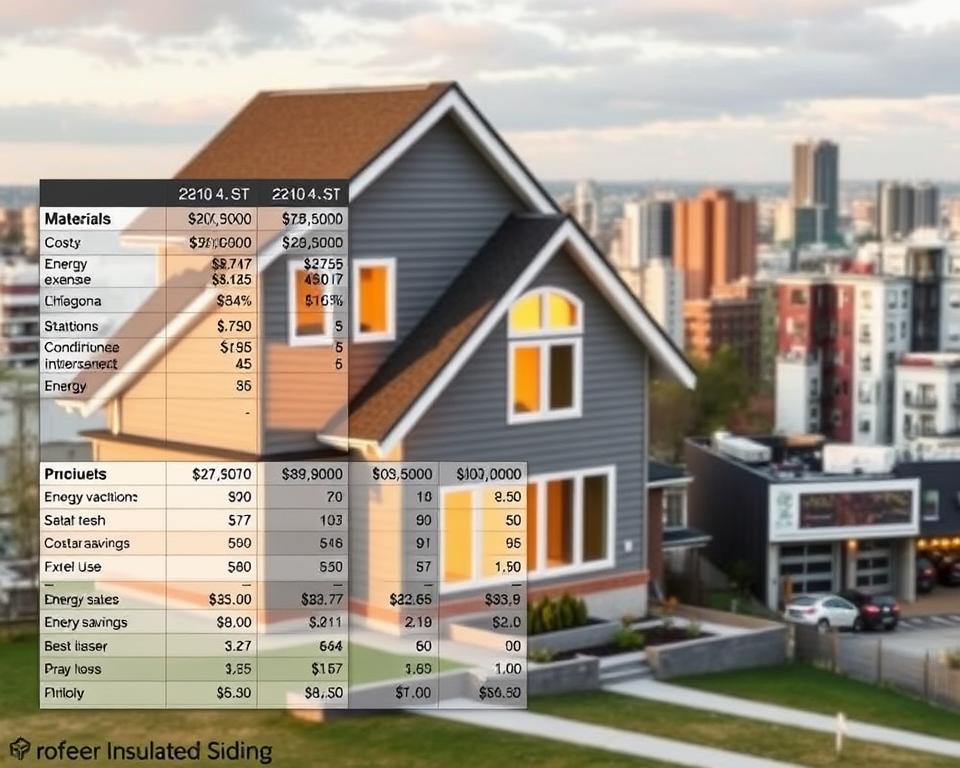
Maintenance Costs Over Time
Insulated siding lasts longer and is less prone to damage. This means you’ll spend less on repairs or replacements. Its impact resistance and moisture management help it last longer.
Tax Credits and Energy Incentives
Installing insulated siding might get you tax credits and energy incentives. These can change, so check with local authorities and energy providers for the latest.
Property Value Increase
Insulated siding can also boost your home’s value. It makes your home more energy-efficient, durable, and attractive. This can help if you decide to sell your home in the future.
In summary, while insulated siding costs more upfront, its long-term benefits are significant. You’ll save on energy, maintenance, and might get tax credits. Plus, it can increase your home’s value, making it a smart investment.
Conclusion: Is Insulated Siding Right for Your Home?
Insulated siding is a great choice for those wanting to make their homes more energy-efficient. It helps improve your home’s insulation. This makes it easier to decide on exterior renovations.
Insulated siding beats traditional siding in many ways. It cuts down on heat loss, boosts insulation, and keeps your home quiet. You’ll also see your home last longer.
Think about the cost now versus the savings later. Insulated siding might cost more upfront. But, it can save you money on energy and even increase your home’s value.
Choosing insulated siding can make your home better in many ways. It makes your home more comfortable and energy-efficient. This is a smart choice for any homeowner looking to upgrade.

